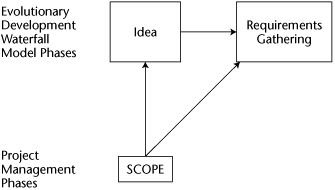The Scoping Phase of the Iterative SDPM Strategy for the Evolutionary Development Waterfall Model
Figure 18-1 illustrates the project management Scoping Phase integrated with the Idea and Requirements Gathering Phases of the Iterative SDPM strategy of the Evolutionary Development Waterfall model. This is the last variation of the Standard Waterfall Model I discuss. The Scoping Phase here is quite similar to the Scoping Phase of the Linear SDPM strategy for the Standard Waterfall model and the Scoping Phase of the Incremental SDPM strategy for the Staged Delivery Waterfall model. All three strategies begin with an idea that is further described and documented through a requirements gathering exercise. The major difference with the Iterative SDPM strategy for the Evolutionary Development Waterfall is that the features list is not complete, and so the strategy requires a number of iterations around the known solution to discover those missing features.
Figure 18-1. The Project Management Scoping Phase integrated with the Idea and Requirements Gathering Phases of the Evolutionary Development Waterfall model

In addition to preparing the Project Overview Statement (POS), you perform four other scoping tasks once you are in the Scoping Phase for the entire project. They are as follows:
Gathering requirements
Generating the Requirements Breakdown Structure (RBS)
Defining the functions ...
Get Effective Software Project Management now with the O’Reilly learning platform.
O’Reilly members experience books, live events, courses curated by job role, and more from O’Reilly and nearly 200 top publishers.

